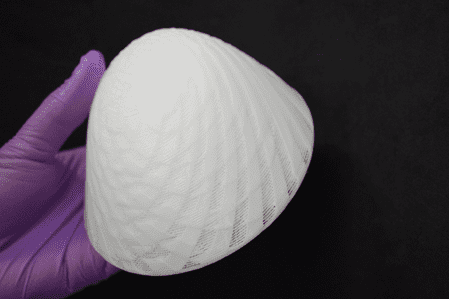



Solving previous breast reconstruction issues.
Breast reconstruction surgery commonly employs artifacts such as silicone implants, or uses autologous patient tissue, but each has advantages and disadvantages. Reconstruction with silicone implants has little post-operative pain and does not require new wounds to be reconstructed, but it is difficult to feel the warmth of the original breast and needs to be replaced approximately every 10 years. On the other hand, reconstruction using autologous tissue does not require the use of implants, but there are still many issues that require more time for the surgery to be completed and creates new scars from where the tissue is taken. Therefore, there is a need for a third method of breast reconstruction that can resolve these issues.
Developing elaborate 3D printable implants that can be absorbed into the body, creating a third reconstruction method
Bellaseno is a German company that is researching a new reconstruction method using its own 3D printer. The polymer material used as the material is precisely printed with a 3D printer to produce an implant.

By creating an implant using the patient’s own body fat, an implant that is slowly absorbed back into the body to become natural breast tissue can be achieved. Implants need not be permanently implanted in the body, avoiding the risks of long-term medication and repeated surgery. 3D printing is the key to this research. The implant is made from a polymer (polycaprolactone) that is discharged from the dispenser nozzle in a stacking structure. The structure is extremely precise and complicated, so a small diameter and high precision nozzle is required for the application. It is important to control the polymer carefully, discharging and stopping the material up to several hundred times per minute, but without allowing material to drip or become clogged.。
▼ Breast reconstruction video developed by the company
Tecdia’s unique tip lapping and internal taper dispenser nozzles deliver success
Tecdia dispenser nozzles have a special “lapped tip” in which the end face of the nozzle is polished. Flattening the end face suppresses issues such as drops and stringification of material. Although this polymer material was difficult to handle due to its low viscosity, Tecdias unique processing technology enables it to be used as a nozzle for 3D printing breast implants as produced by Bellaseno in Germany. In addition, in order to improve fluidity and accurately discharge in accordance with the printer signals, the syringe and nozzle have the same diameter. This enables the material to be consistently discharged even through a small nozzle with 150 μm diameter, ultimately successfully creating the 3D prints required by customers.
Tecdia enables Bellaseno to create 3D printed breast implants as sought after by their customers.
Production is scheduled to start around 2020.Bellaseno’s research is currently in the preclinical stage, but plan to mass produce for hospitals and their patients at their factory by 2020. Tecdia, industry leaders at small-diameter drilling and machining, has a lineup of dispenser nozzles with tip diameter starting at 30μm or smaller.
Bellaseno Germany
Bellaseno is offering ISO 13485 compliant contract manufacturing services for 3D cell culture meshes and custom scaffolds for research use. Please see https://www.bellamake.de/ for more details.
 +1-408-748-0100
+1-408-748-0100
Office Hours: 8:30am - 5:30pm PST
